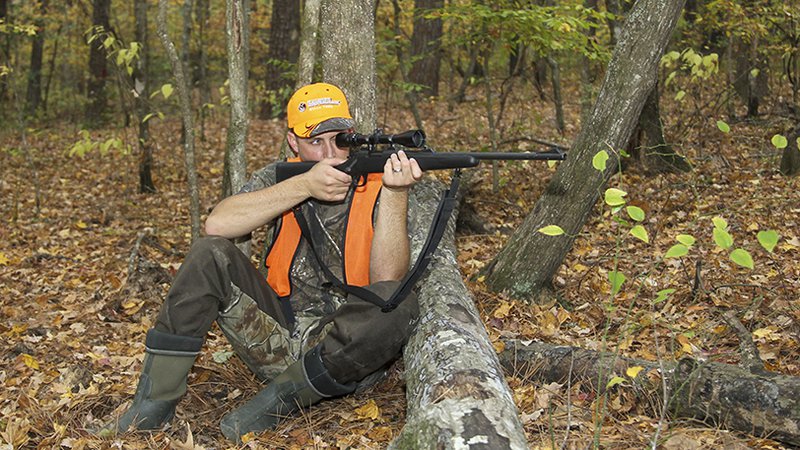Five tips to improve your deer hunting odds on public land
BY agfc
ON 10-30-2019

Oct. 30, 2019
LITTLE ROCK — According to the Quality Deer Management Association’s 2019 Whitetail Report, approximately 60 percent of Arkansas deer hunters each year check at least one deer. This success rate is the fourth-highest for deer hunters in the nation. Considering more than 350,000 deer hunters take the woods each year, that success rate is pretty impressive. Even so, some deer hunters are destined to walk away from the woods empty-handed, especially on public land. Here are five tips from Arkansas Game and Fish Commission Deer Program Coordinator Ralph Meeker to up your odds this season.
Put your time in at class

Hunters should research both the size of the area and historical harvests of both bucks and does for the public area they intend to hunt. This will provide hunters with a rough idea of the local deer population and hunting pressure. Deer harvest reports can be found at www.agfc.com/deerharvest. Also, hunters should thoroughly read the regulations for the area they intend to hunt and understand that wildlife management areas are their own deer zone. Each WMA has a web page devoted to season dates and regulations at www.agfc.com/en/hunting/where-hunt.
“For example, White Rock WMA is Zone 670 with different season dates and limits from Private Land Deer Zones 1, 1A, 2 and 6 that surround it,” Meeker said. “Certain areas require permits to be acquired before deer hunting. Some public areas also implement more aggressive minimum antler characteristics to protect a larger percentage of younger age-class bucks.”
Use technology
Many phone apps and mapping software packages can help hunters either find and mark locations in the field or assist with navigation. Quite a few of these are free. Aerial images through tools like Google Earth are excellent tools to identify, mark and later field-proof things such as deer travel corridors, bedding areas, food plots and potential stand sites.
Boots on the ground
Public land hunters have to learn the playing field. Those who show up the morning of the hunt and expect to bag a big buck are betting against the house’s odds. Getting out of the truck and looking for cover and food deer will most likely use and how they relate to the topography of the land improves the player’s odds.
“Even if you don’t succeed this season, get out after the season is over and put in some time on areas you want to learn more about,” Meeker said. “Finding deer sheds in March and April lets you know where the deer go during the season and gives you an idea of the bucks on the property that survived the previous season.”
Stay in the stand
You can’t score if you’re not in the game. It may sound simple, but patience and time in the stand are two elements that separate most successful hunters from those with unfilled tags.
“I analyze thousands of deer hunter observation records each year,” Meeker said. “The resulting data clearly shows that most deer hunters will arrive at their stand before daybreak but leave around 9:30-10 a.m. Likewise, evening hunters will arrive in their stands around 2:30-3 p.m. and leave after sunset around 5:30-5:45 p.m.
Meeker says not only should hunters plan to hunker down for longer hunts, but also to pattern the hunters as well as the deer.
“Locate escape corridors and cover,” Meeker said. “Hunters who opt to stay in their stands until after a morning’s mass exodus or be in the stand well before the evening’s great arrival will definitely increase their chance of harvest.”

Go where no one has gone before
About 16 percent of Arkansas hunters primarily chase deer on public land. Another 10 percent mix their time between public and private land hunts. That means as many as 87,000 hunters will be looking for a deer on publicly accessible areas each year. Arkansas is blessed with more than 3 million acres of public hunting lands, but sometimes finding a quiet place to hunt can be a challenge. But, according to Meeker, one-third of a mile may be all it takes to separate you from the masses and hunt fresh territory; maybe less if you don’t mind a slight uphill route.
“Research conducted by Penn State University examined how deer hunters used the Sproul State Forest in Pennsylvania during deer season,” Meeker said. “What they found is that a vast majority of deer hunters hunted within 550 yards of an access road. In addition, an area was 1.5 times less likely to be hunted for every 5-degree increase in slope. Put those two findings together and what you get is 87 percent of hunters hunted on 56 percent of the 114,000-acre study area. Deer make their living by escaping predators. If hanging out more than 550 yards from the road in steep terrain is going to keep them alive, guess where they’ll be.”
Recent News

AGFC Commissioner Meeting Notice
Jul. 15, 2025
Subscribe to Our Weekly Newsletter E-mails
Don’t miss another issue. Sign up now to receive the AGFC Wildlife Weekly Newsletter in your mailbox every Wednesday afternoon (Waterfowl Reports are published weekly during waterfowl season and periodically outside the season). Fishing Reports arrive on Thursdays. Fill in the following fields and hit submit. Thanks, and welcome!

